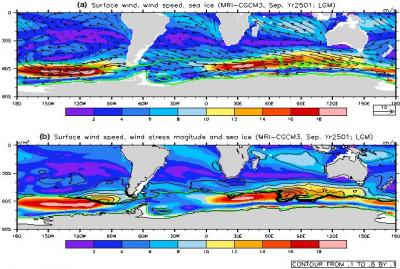The De-Correlation of Westerly Winds and Westerly-Wind Stress over the Southern Ocean during the Last Glacial Maximum
When comparing the behavior of southern westerly winds during the peak of Earth’s last major glacial period to the same winds today, scientists were puzzled because geological and oceanic evidence appeared to be contradictory. Compared to recent times, the southern westerlies deposited dust at a greater rate during the last glacial maximum suggesting they were stronger and shifted more toward the South Pole. By contrast, reconstructed ocean temperatures based on isotopes and fossil organisms indicate the westerly winds shifted toward the equator as the Antarctic ice sheet advanced in the same direction. Climate models under the auspice of the Paleoclimate Model Inter-comparison Project phase 3 (PMIP3) also gave disparate answers in regard to the southern westerly winds during the last glacial maximum.
Combining both the PMIP3 simulations and several reconstructions of historic conditions, researchers, including Department of Energy scientists from Pacific Northwest National Laboratory, took another careful look at the issue and pieced the puzzle together by reconciling the atmospheric perspective from dust deposition with the oceanic perspective from reconstructed ocean conditions. A key factor causing the confusion was that lower-tropospheric winds and surface winds seemed to be acting independently of each other. That “de-correlation” was due to the advance of Antarctic sea ice toward the equator, greatly reducing the impact of the south westerlies over the liquid ocean. Two models were able to capture this nuance and adequately represent present-day southern westerlies and sea ice conditions. Both models simulate the greatest advance of Antarctic ice during the last glacial maximum. That advance accounts for weakening wind stress that shifted toward the equator as well as stronger winds that shifted toward the pole—consistent with dust deposition data. Thus, the conflicting reconstructed prehistoric records can be reconciled.
This work is primarily supported by NSF AGS-1249145. Jian Lu and L. Ruby Leung were partly supported by the Office of Science of the US Department of Energy as part of the Regional and Global Climate Modeling program. The Pacific Northwest National Laboratory is operated for DOE by Battelle Memorial Institute under contract DE-AC05-76RL01830.

